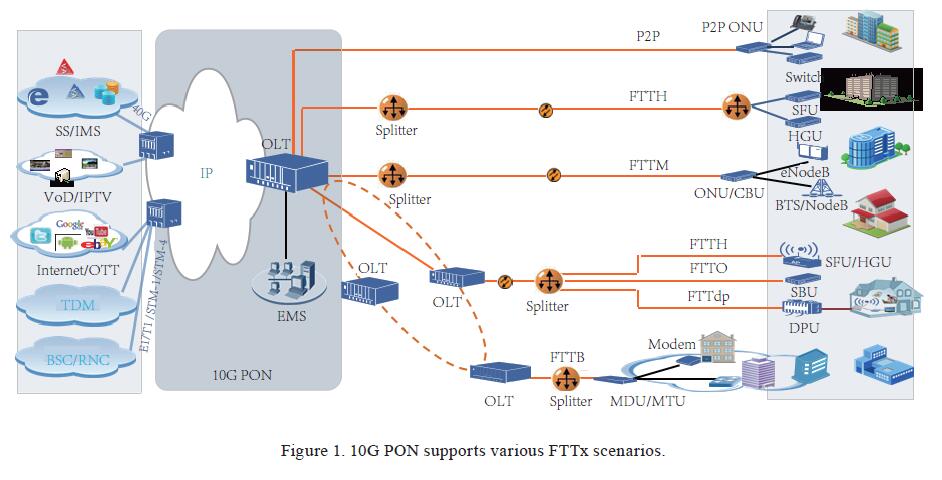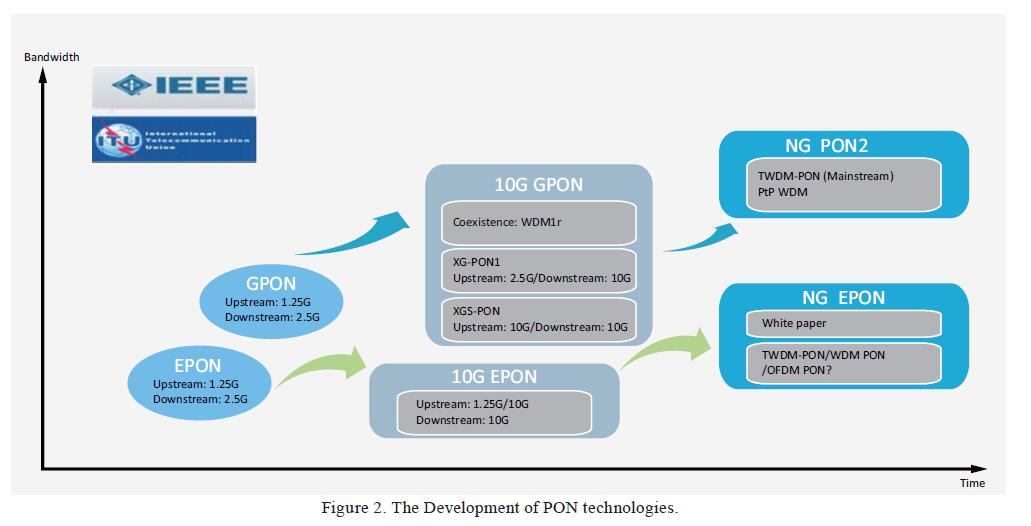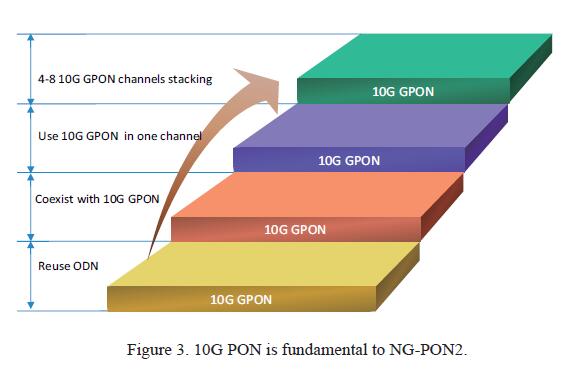A Discussion of NG-PON Evolution Trends
Network-based applications have rapidly emerged in recent years. In particular, high-quality video services such as 3DTV, HDTV, 4KTV, or even 8KTV and virtual reality (VR), are offering customers amazing entertainment experience. The number of devices connecting to the network has dramatically increased. There are a plenty of portable internet devices like mobile phones or tablets available nowadays. This means there are growing needs for bandwidth. Nielsen’s Law says that the bandwidth available to users increases by 50% annually. To satisfy such a quick growth, PON needs to be widely deployed.
1G PON including GPON and EPON usually supports a bandwidth of 20 to 50 Mbps for end users. This is not enough for some applications like 4KTV. Therefore, the 10G PON concept has appeared as an evolution of 1G PON. ITU-T has proposed XG-PON1 with a double upstream rate of 2.5 Gbps and a fourfold downstream rate of 10 Gbps. IEEE has also introduced 10G EPON that can increase downstream rates to 10 Gbps. High upstream bandwidth is critical in certain applications. XGS-PON, a symmetric-bandwidth version of 10G PON has been developed to offer 10 Gbps data rates in both upstream and downstream directions.
The study on 10G PON has completed. A series of standards have been released describing the specifications, including IEEE’s 802.3av for 10G EPON and ITU-T’s G.987.x series and G.988 for 10G GPON. Based on these standards, mass production of 10G PON devices is possible.
Benefiting from the mature industry chain and good performance, 10G PON has gradually evolved into the mainstream PON technology applicable to multiple scenarios such as buildings and residential districts reconstruction; high-End family, enterprise and campus broadband access; and mobile backhaul. More importantly, through ODN reuse and proper wavelength deployment schemes, 10G PON can perfectly coexist with 1G PON. This also means operators can easily achieve smooth network evolution. Such coexistence helps traditional operators improve user experience, increase user stickiness, and maintain their competitiveness; and provides emerging operators with differentiated ideas to enhance their competitiveness.

In this scenario, the access bandwidth of 10G PON is fully used to provide wide coverage and a high access bandwidth of 100 Mbps or even 1 Gbps. In cost-sensitive scenarios, existing resources such as CAT-5 and twisted-pair cables can also be fully used for fast deployment and service provisioning. This reduces capex. In a copper-to-the-home case, VDSL2 and Vectoring can be used to offer a broadband access experience comparable to that brought by FTTH.
10G PON is the best choice for high-end users because its access capacity reaches as high as 1 Gbps or even 10 Gbps. This satisfies the requirements of both enterprise and family users such as high-speed internet access, cloud storage, ultra-HD videos, and 3D/VR online games. In this scenario, 10G PON access is used to help operators increase user satisfaction and thus cement and even raise their revenues.
In the era of mobile internet, mobile communication occupies a significant share in the telecom market. It is therefore necessary to provide operators with a flexible and low-cost access solution that can carry massive mobile traffic. 10G PON applicable for various indoor and outdoor scenarios is the optimal solution to address the needs. 10G PON and smallcell are perfectly matched in terms of development and bandwidth provision. The existing FTTx and PON resources also greatly facilitate high-density LTE smallcell deployments.
Although the current mainstream 10G PON can guarantee a vast majority of telecom services, there are growing needs for higher bandwidth. Ultra-high-definition video services such as VR and 8KTV as well as new-generation mobile communication technologies like Pre5G and 5G all need a huge amount of bandwidth and may trigger a bigger burst of traffic in the future. Early in 2009, FSAN began research into next-generation PON (NG-PON2). In 2012, FSAN selected TWDM-PON as the mainstream NG-PON2 technology and PtP WDM PON as a supplement. This was also regarded as a milestone in the NG-PON2 development. By the end of 2015, FSAN had finalized several technical recommendations including G.989.1, G.989.1 Amd1 and G.989.1 Amd2. IEEE is also engaged in researching NG-EPON and considers it as the evolution trend of 10G EPON (Fig.2).

The main idea of TWDM-PON is to combine the WDM mechanism with the existing TDM mechanism in the PON. Several wavelengths or channels of 10G GPON are multiplexed into one channel to bring a bandwidth as high as 10 Gbps. In this way, the tremendous carrier capacity of optical fiber could be fully used.
NG-PON2 is developed upon 10G PON and can be fully compatible with the existing 10G PON (Fig.3). This also means the evolution to NG-PON2 can be easy, smooth, and economical. Usually four, or eight, or even more 10G PON wavelengths are stacked for on-demand network upgrade and fast broadband connection. At the user side, colorless ONUs in NG-PON2 use tunable transmitters and receivers to ensure normal operation on any upstream and downstream wavelength.

Nowadays, the G-989 series of standards for NG-PON2 are under research. NG-PON2 technical indicators and management modes still need to be discussed and specified. Moreover, the progress of NG-PON2 commercialization is highly restricted by the immature industry chain. Most NG-PON2 products are still unveiled as prototypes. There is a great shortage of some key components like optical modules with standard encapsulation. These factors make the cost of NG-PON2 much higher than that of XG-PON1. It is expected NG-PON2 will be widely commercialized in 2020.
ZTE: The Technology Leader in NG-PON
ZTE leads the 10G PON industry. It is the first vendor in the industry to launch the 8-port high-density ASIC 10G PON card that complies with IEEE 802.3av, ITU-T G.987 and G.988 standards. With the ASIC 10G PON portfolios including OLT, MDU, SFU/HGU and CBU/CTU, ZTE’s end-to-end 10G PON solutions have widely deployed by operators around the world. These solutions are featured by clock and time synchronization, H-QoS, unified-management platform, and optical link quality diagnosis by built-in OTDR modules. ZTE can also help operators reduce their opex and capex. The PON cards and optical modules are designed to be pluggable for easy switching and upgrade. By introducing energy-saving chipsets, smart speed-adjustable fans, and power-saving management, ZTE’s 10G PON products are highly energy efficient.
ZTE also provides smooth evolution to NG-PON2 through its excellent platform. With high switching capacity and unified architecture, NG-PON2 can coexist with 1G/10G PON, helping operators save capex. During the evolution, existing platform features such as carrier-class security and reliability, full-service operation, rich uplink and downlink interfaces, and outstanding service performance can be fully inherited. Successful operations worldwide have proven that ZTE is a reliable partner. The company is poised to partner with operators worldwide in embracing the promising next-generation PON.